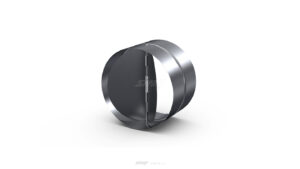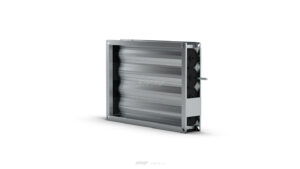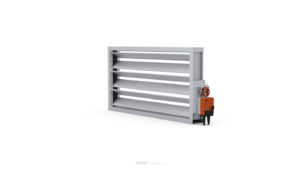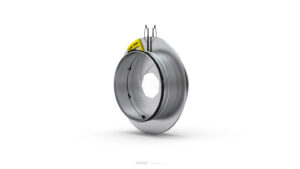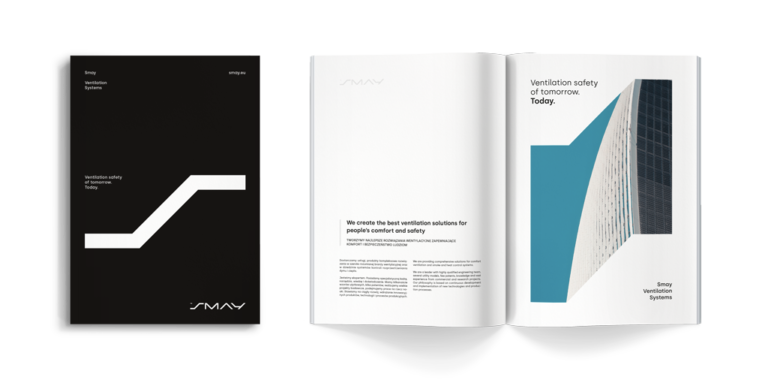Advantages of SMAY dampers
- High air tightness class (up to C4).
- ATEX certificate.
- Increased working pressure (up to 2,500 Pa).
- Increased operating temperature (up to 350°C).
- No plastic elements.
- Concealed driving mechanism.
- Possibility of insulating damper blades.
- Possibility of painting.
Product range
SMAY’s portfolio includes many dampers for ventilation ducts. We offer the following devices:
- multi-blade,
- single-blade,
- lenticular,
- returnable (with return flap valves).
SMAY also manufactures dampers for pressure differential systems (SRC), as well as dampers used in explosive atmospheres (PWIIS-EX). We offer dampers with an electric actuator, with a manual mechanism, and with a free shaft for an actuator installation.
We also offer dampers for ventilation accessories:
- backward,
- concurrent,
- slotted,
- pivoting.
Due to the shape of ventilation ducts it is possible to distinguish circular and rectangular dampers.
Operating principle
In supply and exhaust systems, the flow of air stream can be adjusted by means of a damper mounted in a ventilation shaft. It makes it possible to control air distribution. The flow is adjusted by changing the position of a damper (damper blades). This makes it possible to obtain a suitable stream of supply air, and to properly distribute pressure in the system.
The opening angle of the damper blades can be set by means of a manual mechanism or automatically, by means of 24 V or 230 V control actuators. It is also possible to buy a damper adapted to an unaided installation of an actuator. The driving force is transferred to other blades by means of gear wheels or a set of levers and tie rods arranged backwardly or concurrently. The dampers also make it possible to shut off the air supply, which may be useful in industrial facilities in order to control temperature by limiting the volume of cold air supplied to rooms.
Read more
Przepustnice wentylacyjne – podział i zastosowanie w różnego rodzaju instalacjach
Damper technical parameters
The air tightness and air flow control range are essential parameters of ventilation dampers. The air tightness classes of dampers are determined on the basis of tests carried out according to PN-EN 1751:2014. Different damper designs make it possible to reach air tightness classes from AX to the highest possible rating of C4.
The operating temperature range of dampers is -20°C to +90°C. In case of dampers without any plastic components it can even be up to +350°C. If a damper is controlled by an actuator, operating temperature must not exceed +50°C.
Design
Dampers are made of galvanised or stainless sheet metal. They also have aluminium profiles that are used for making bodies and damper blades.
Dimensions and installation of dampers
The dimensions of dampers for rectangular ducts range from 100 mm × 105 mm up to 3,000 mm × 2,810 mm. For dampers designed for circular ducts, we offer diameters from 80 mm up to 1,250 mm. We also deliver custom orders. The dimensions are provided in the data sheets for a given product.
It is possible to install the devices:
- in a rectangular duct,
- in a circular duct,
- in an air handling unit,
- in a wall.
You can read more about the installation in the following article: “How to properly install ventilation dampers?”.
Certificates and legal requirements
The devices manufactured by SMAY have sanitary certificates, declarations of conformity and the National Technical Assessments. The dampers conform to the requirements of PN-EN 1751:2014.
The PWIIS-Ex dampers with the ATEX certificate may be used in ventilation systems in explosive atmospheres. The devices have been examined and qualified to Group II of 2nd Category according to PN-EN ISO 80079-36:2016 and PN-EN ISO 80079-37:2016. It means that the products may be installed in zones 1 and 2 as well as 21 and 22.


